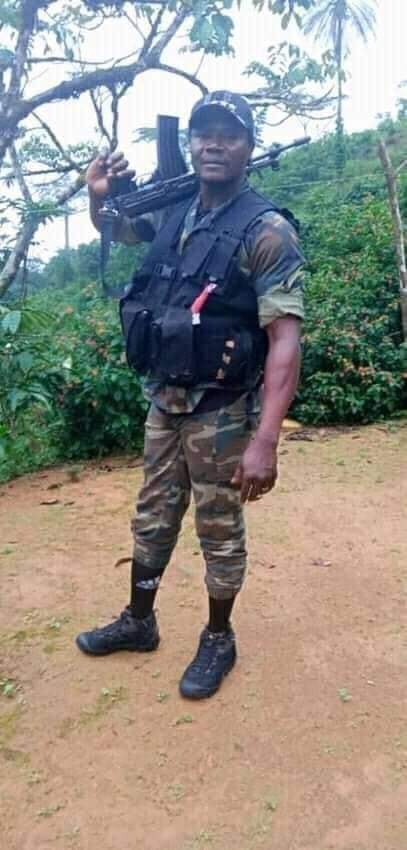Renowned Ambazonian commander, Oliver Lekeaka, better known as ‘Field Marshal’, was killed this week near Menji in Lebialem, South-West Cameroon. The circumstances remain unclear, but reports strongly suggest that he was not directly killed by the military. Instead, it seems likely that he was killed by a rival separatist, perhaps enticed by a financial arrangement with the military. Rifts between separatist groups and leaders in Lebialem have been noted for some time, and so this isn’t entirely surprising, and given that the BIR were able to raid his camp and recover his body relatively quickly hints quite clearly at collaboration in some form. Rumors abound as to which group or person was directly responsible, and it is possible that we may never know the full truth. What is absolutely true, however, is that Field Marshal is dead.

The military of Cameroon is celebrating this as a major coup, and in some ways it is. Lekeaka was the most prominent Ambazonian commander remaining from the early days of the conflict. His exploits with the Red Dragons in 2018 and 2019 earned him plaudits across the separatist community, with the nearly impassable topography of Lebialem providing ample refuge to his Red Dragons. His death is therefore undoubtedly a loss to the armed separatist cause.
Yet in truth, I believe this to be more a propaganda coup than a victory that actually has a material effect on the situation on the ground.
Lebialem was an epicenter of the conflict in 2018, with some of the fiercest fighting to date. Lekeaka’s Red Dragons were largely responsible for this. They were better armed than most groups at that early stage of the conflict, and they were able to use the highly inhospitable terrain of Lebialem to their advantage. They took a significant toll on the military. However, the Red Dragons were essentially degraded as a fighting force by two key factors. Firstly, one of the Red Dragon’s stronger commanders, General Ayeke, left with some fighters to form a rival group known as the ‘Gorilla/Guerilla Fighters of Alou’. Together with another group, known as the ‘Ambazonian Liberation Army’ under General Die-Man, they proceeded to contest Lebialem, at times against the Red Dragons themselves. This infighting was seriously detrimental to separatist efforts in the region. The second key factor was increased, effective military operations in late 2020. The death of General Ayeke during one such military operation in October 2020 was a further blow to separatist activity.
The fracturing and infighting of different separatist groups further undermined their hold on the division. Ultimately, by 2021 and 2022, the number of battles with the military and separatist control in Lebialem was significantly reduced. ACLED data supports this, also revealing that as attacks on the military (and separatist strength) declined, attacks on civilians increased. Separatist groups still have a presence in Lebialem, of course, but in truth, it has not been a hotspot of the conflict for some time. Some on the government side perceive Lebialem to be a rare success story of the conflict, as a place where the military had essentially defeated the separatists.
Field Marshal and the Red Dragons had not been heavily involved in fighting for some time, and it so it was with some surprise that the Red Dragons reemerged this month with the alleged attack on Sanchou Market in the West region. The subsequent loss of Field Marshal essentially heralds the extinction of the Red Dragons as a functional, effective fighting force, and given the intense infighting and fracturing in the area, it is difficult to see the Red Dragons recovering in the near future.
Lekeaka was the brother of noted Ambazonian firebrand, Christopher Anu, formerly a powerful figure within Interim Government (Sako). It remains to be seen what impact and influence Lekeaka’s death will have on his work.
All this is to say that whilst this is undoubtedly a significant propaganda coup for the government, unless it has a catastrophic demoralizing effect on other groups, it means relatively little for the state of the conflict on the ground. Developments in Mezam Division and elsewhere are far more consequential.

Finally, it is worth noting that the military displayed the decomposing body of Lekeaka in Kumba today, a significant amount of time after his death. This has become common practice by the Cameroonian military. The bodies of dead separatists (or suspected separatists) are left on display in prominent places by the military with increasing regularity, as seen in Bamali, North-West region, in mid-June. Underlining the grim use of bodies for political ends, Lekeaka’s body was rumored to be taken on tour to Alou, Dschang, and elsewhere in Cameroon. However, photos suggest that he was buried near Kumba today.
This concerning practice approaches the threshold of crimes under international law.

Cameroon, as a signatory to both the Geneva Conventions and Additional Protocol 1, is bound to:
Geneva Convention IV
Article 16, second paragraph, of the 1949 Geneva Convention IV provides: “As far as military considerations allow, each Party to the conflict shall facilitate the steps taken … to protect [the killed] against … ill-treatment.”
Additional Protocol I
Article 34(1) of the 1977 Additional Protocol I provides: “The remains of persons who have died for reasons related to occupation or in detention resulting from occupation or hostilities … shall be respected”.





















